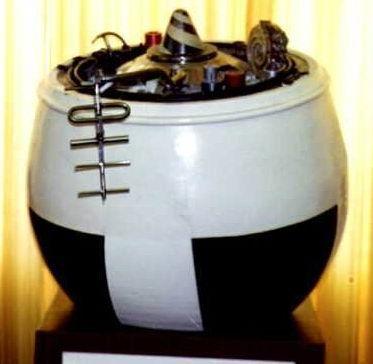Soviet spacecraft launched over 50 years ago is heading to Earth

The craft could soon enter the Earth's atmosphere after more than 50 years in space
- Published
A piece of a Soviet spacecraft launched in 1972 is expected to crash back down to Earth very soon, experts say.
The part, which is from the Cosmos 482 probe, was meant to land on the planet Venus.
While it made it into space successfully, the spacecraft wasn't able to complete its journey after something went wrong.
Most of the remains of the rocket eventually came back to Earth within the 10 years that followed.
But one final section, which experts say is the landing capsule or lander module, ended up stuck in space. It's now been there for 53 years.
More of the latest space stories
- Published3 days ago
- Published5 days ago
- Published27 April
What exactly happened?

There is a model of the landing capsule, called Venera 8, at the Lavochkin Museum in Russia
The part of the spacecraft which was supposed to land on Venus was sent to the super hot planet to carry out scientific measurements, scientist Dr Marco Langbroek from Delft University of Technology (TU Delft) explained to Newsround.
"The engine of the rocket that launched it stop working too early, so it was left stranded in an orbit around the Earth," he said.
"It then broke up, with the lander module that was supposed to land on the surface of Venus detaching from the main spacecraft.
"The main spacecraft, which was large and heavy, burned up in the (Earth's) atmosphere long ago...but the lander module kept orbiting the earth."
What will happen next?

The lander module was supposed to land on the planet Venus
As the landing capsule has been orbiting Earth in space, it has also been steadily falling towards Earth.
"...Within a few days, it will be so low that it can no longer do a full round around the Earth," Dr Marco told us.
It will eventually enter the Earth's atmosphere, slowing down quickly in the process.
"It will briefly become very hot, just like a shooting star. It will then fall down to earth, almost vertically," Dr Marco says.
He predicts the spacecraft will enter the Earth's atmosphere around the 10 May and that its final speed will be similar to that of "a high-speed train or very fast race car".

The spacecraft is likely to land in the sea when it reaches Earth
It's not yet known whether the piece of the spacecraft will survive its journey back to Earth, or whether it'll burn up as it crashes through the planet's atmosphere.
But the risk of anyone or anything getting in the way of the plunging lander module is very low. It could hit the ground, or will most likely enter the sea.
"You have a higher risk of being hit by lightning once in your life, than being hit by this falling spacecraft," Dr Marco told us.
Although it's unlikely the lander will remain intact, it would have been full of instruments from over half a century ago, something which some experts are intrigued by.
"It's almost a bit as if a time capsule is falling to Earth," Dr Marco said.
More of the latest
- Published1 day ago

- Published2 days ago

- Published3 days ago

